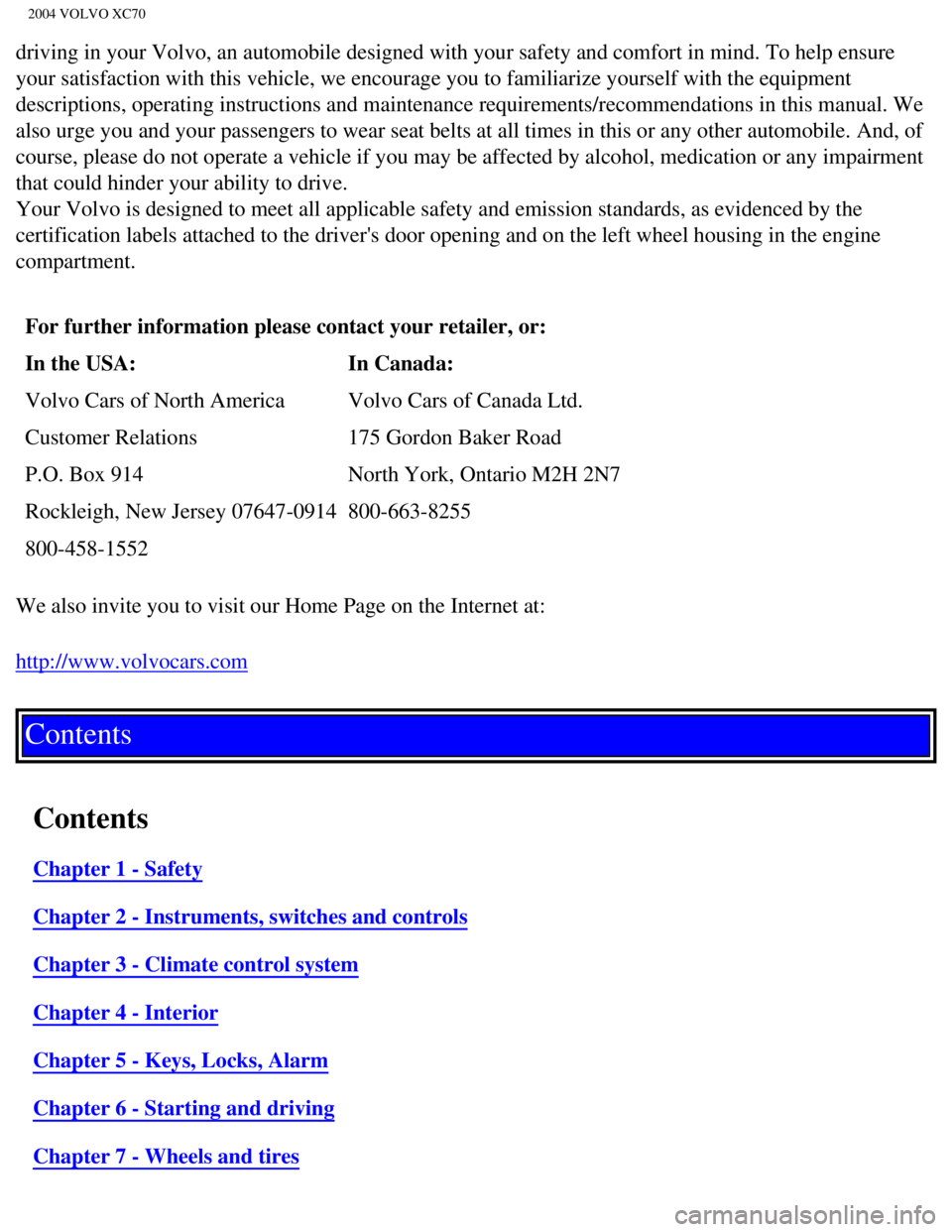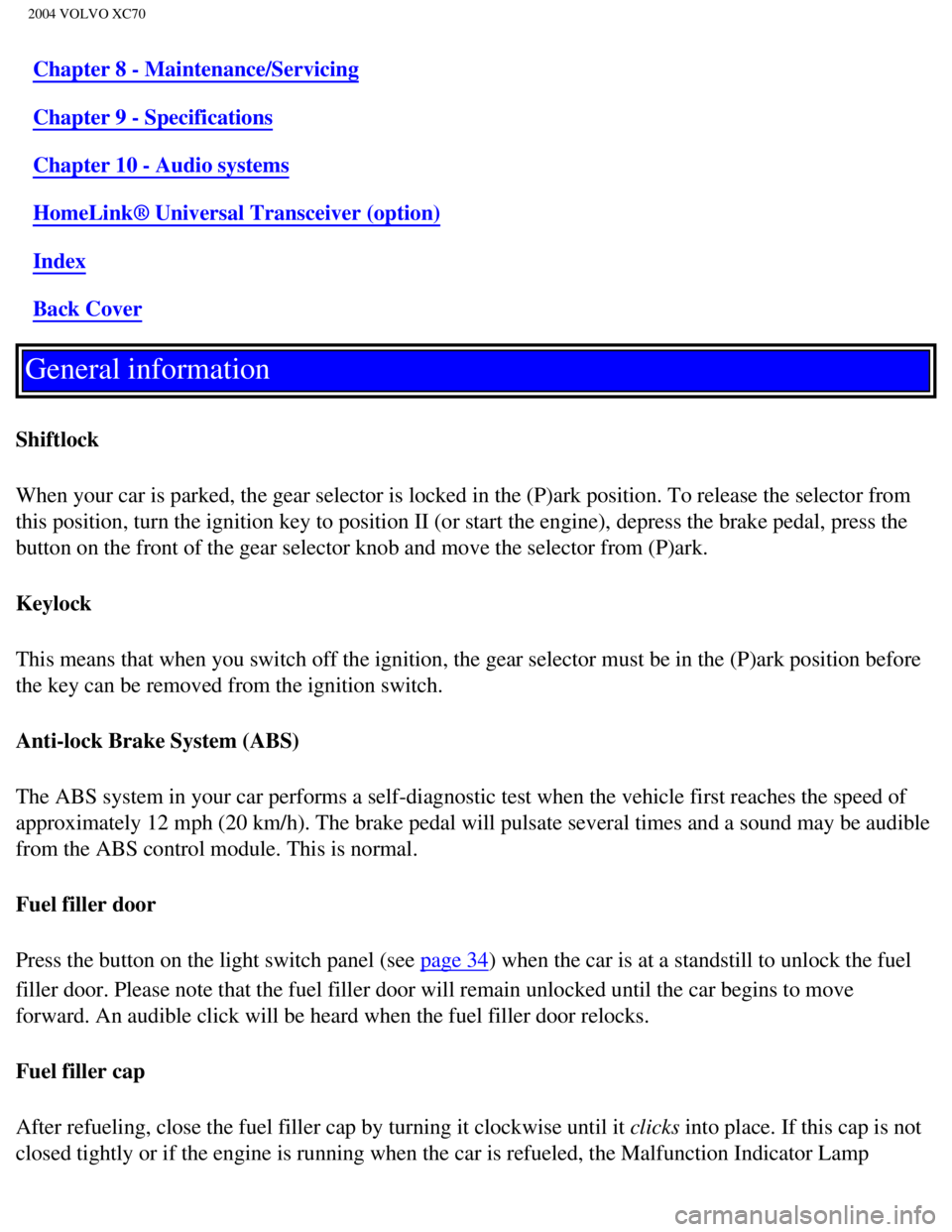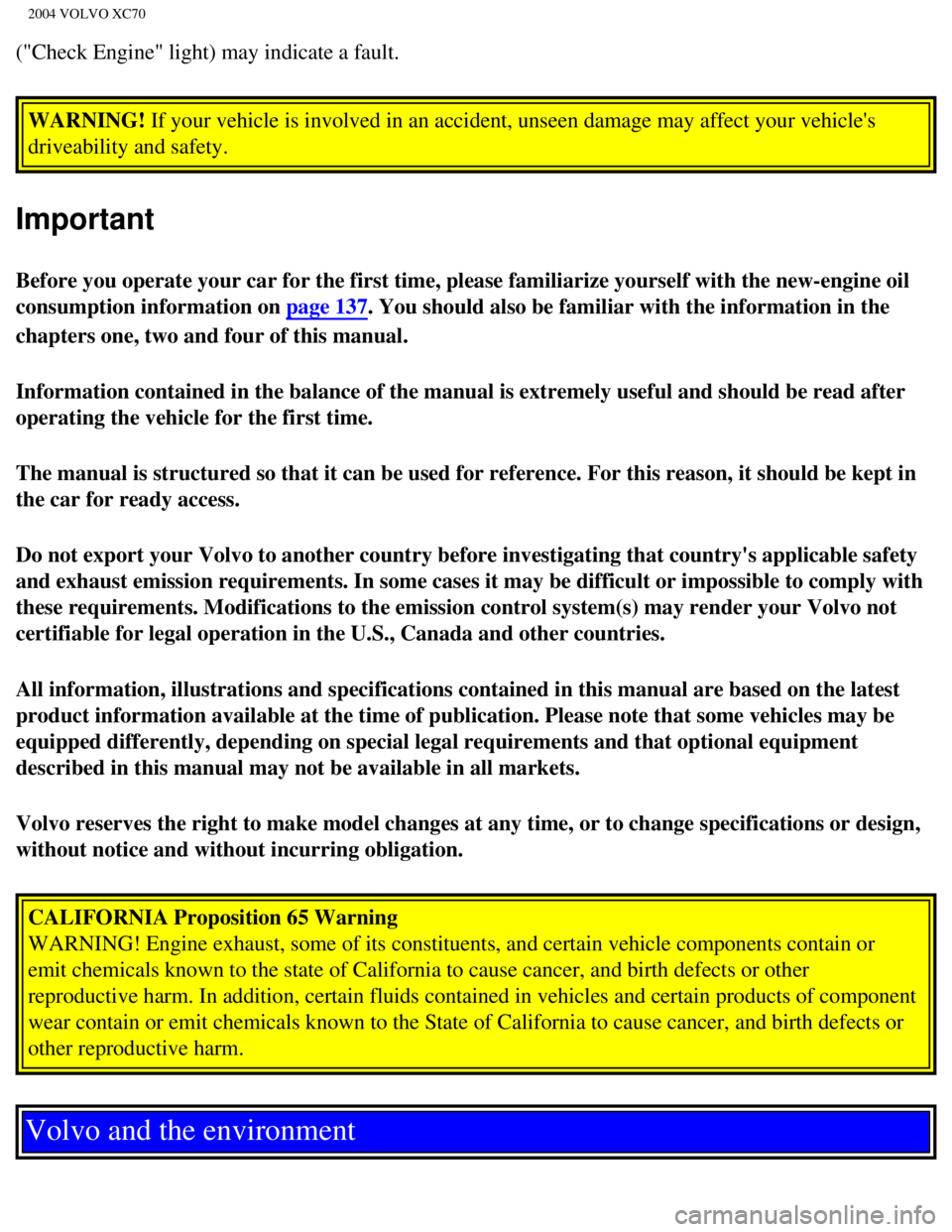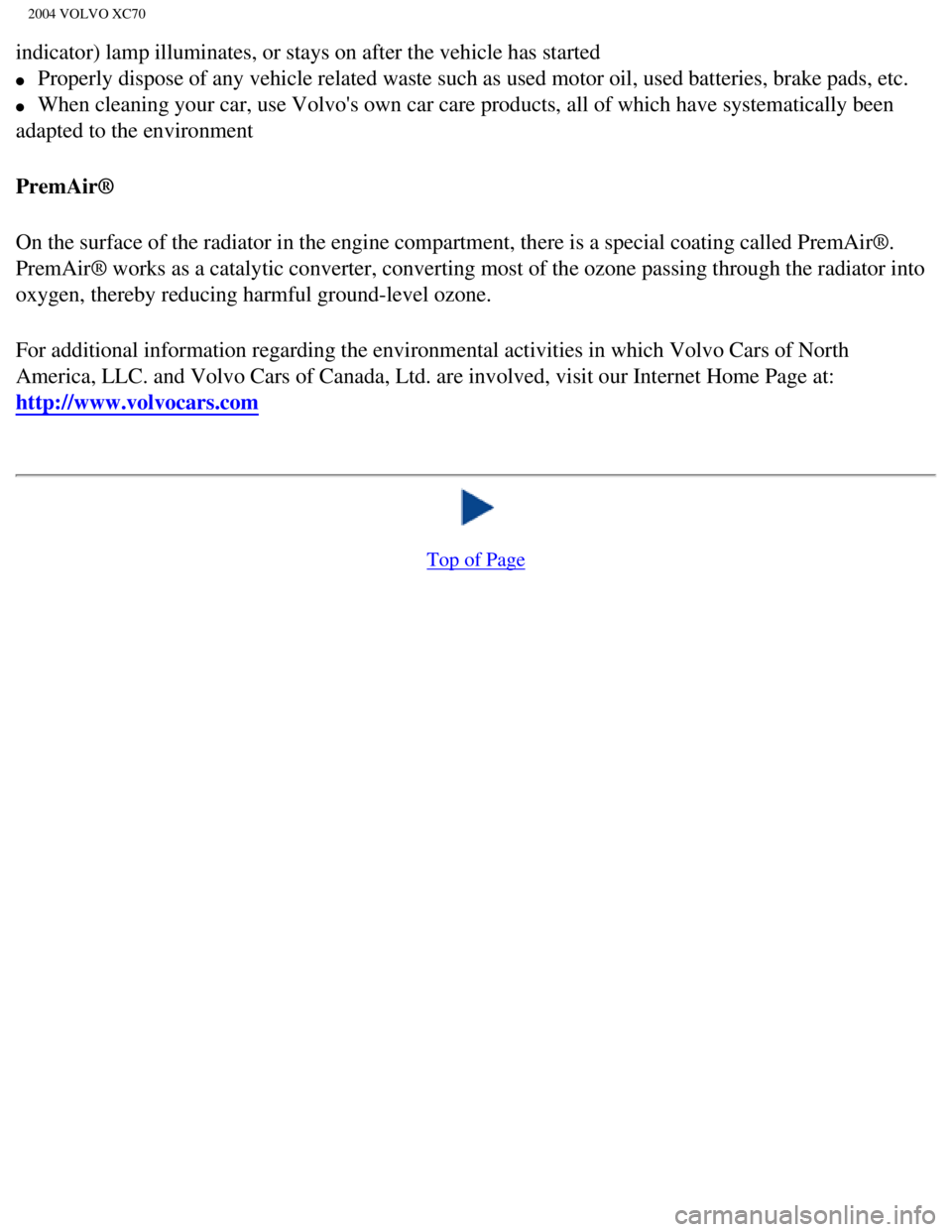engine VOLVO XC70 2004 Owners Manual
[x] Cancel search | Manufacturer: VOLVO, Model Year: 2004, Model line: XC70, Model: VOLVO XC70 2004Pages: 241, PDF Size: 5.78 MB
Page 2 of 241

2004 VOLVO XC70
driving in your Volvo, an automobile designed with your safety and comfo\
rt in mind. To help ensure
your satisfaction with this vehicle, we encourage you to familiarize you\
rself with the equipment
descriptions, operating instructions and maintenance requirements/recomm\
endations in this manual. We
also urge you and your passengers to wear seat belts at all times in thi\
s or any other automobile. And, of
course, please do not operate a vehicle if you may be affected by alcoho\
l, medication or any impairment
that could hinder your ability to drive.
Your Volvo is designed to meet all applicable safety and emission standa\
rds, as evidenced by the
certification labels attached to the driver's door opening and on the le\
ft wheel housing in the engine
compartment. For further information please contact your retailer, or:
In the USA: In Canada:
Volvo Cars of North America Volvo Cars of Canada Ltd.
Customer Relations 175 Gordon Baker Road
P.O. Box 914 North York, Ontario M2H 2N7
Rockleigh, New Jersey 07647-0914 800-663-8255
800-458-1552
We also invite you to visit our Home Page on the Internet at:
http://www.volvocars.com
Contents
Contents
Chapter 1 - Safety
Chapter 2 - Instruments, switches and controls
Chapter 3 - Climate control system
Chapter 4 - Interior
Chapter 5 - Keys, Locks, Alarm
Chapter 6 - Starting and driving
Chapter 7 - Wheels and tires
file:///K|/ownersdocs/2004/2004_XC70/04xc70_00.htm (2 of 6)12/30/2006 \
4:32:53 PM
Page 3 of 241

2004 VOLVO XC70
Chapter 8 - Maintenance/Servicing
Chapter 9 - Specifications
Chapter 10 - Audio systems
HomeLink® Universal Transceiver (option)
Index
Back Cover
General information
Shiftlock
When your car is parked, the gear selector is locked in the (P)ark pos\
ition. To release the selector from
this position, turn the ignition key to position II (or start the engin\
e), depress the brake pedal, press the
button on the front of the gear selector knob and move the selector from\
(P)ark.
Keylock
This means that when you switch off the ignition, the gear selector must\
be in the (P)ark position before
the key can be removed from the ignition switch.
Anti-lock Brake System (ABS)
The ABS system in your car performs a self-diagnostic test when the vehi\
cle first reaches the speed of
approximately 12 mph (20 km/h). The brake pedal will pulsate several t\
imes and a sound may be audible
from the ABS control module. This is normal.
Fuel filler door
Press the button on the light switch panel (see
page 34) when the car is at a standstill to unlock the fuel
filler door. Please note that the fuel filler door will remain unlocked \
until the car begins to move
forward. An audible click will be heard when the fuel filler door relock\
s.
Fuel filler cap
After refueling, close the fuel filler cap by turning it clockwise until\
it clicks into place. If this cap is not
closed tightly or if the engine is running when the car is refueled, the\
Malfunction Indicator Lamp
file:///K|/ownersdocs/2004/2004_XC70/04xc70_00.htm (3 of 6)12/30/2006 \
4:32:53 PM
Page 4 of 241

2004 VOLVO XC70
("Check Engine" light) may indicate a fault. WARNING! If your vehicle is involved in an accident, unseen damage may affect yo\
ur vehicle's
driveability and safety.
Important
Before you operate your car for the first time, please familiarize yours\
elf with the new-engine oil
consumption information on
page 137. You should also be familiar with the information in the
chapters one, two and four of this manual.
Information contained in the balance of the manual is extremely useful a\
nd should be read after
operating the vehicle for the first time.
The manual is structured so that it can be used for reference. For this \
reason, it should be kept in
the car for ready access.
Do not export your Volvo to another country before investigating that co\
untry's applicable safety
and exhaust emission requirements. In some cases it may be difficult or \
impossible to comply with
these requirements. Modifications to the emission control system(s) ma\
y render your Volvo not
certifiable for legal operation in the U.S., Canada and other countries.\
All information, illustrations and specifications contained in this manu\
al are based on the latest
product information available at the time of publication. Please note th\
at some vehicles may be
equipped differently, depending on special legal requirements and that o\
ptional equipment
described in this manual may not be available in all markets.
Volvo reserves the right to make model changes at any time, or to change\
specifications or design,
without notice and without incurring obligation.
CALIFORNIA Proposition 65 Warning
WARNING! Engine exhaust, some of its constituents, and certain vehicle c\
omponents contain or
emit chemicals known to the state of California to cause cancer, and bir\
th defects or other
reproductive harm. In addition, certain fluids contained in vehicles and\
certain products of component
wear contain or emit chemicals known to the State of California to cause\
cancer, and birth defects or
other reproductive harm.
Volvo and the environment
file:///K|/ownersdocs/2004/2004_XC70/04xc70_00.htm (4 of 6)12/30/2006 \
4:32:53 PM
Page 5 of 241

2004 VOLVO XC70
Volvo is committed to the well being of our customers. As a natural part\
of this commitment, we care
about the environment in which we all live. Caring for the environment m\
eans an everyday involvement
in reducing our environmental impact.
Volvo's environmental activities are based on a holistic view, which mea\
ns we consider the overall
environmental impact of a product throughout its complete life cycle. In\
this context, design, production,
product use, and recycling are all important considerations.
In production, Volvo has partly or completely phased out several chemica\
ls including freons, lead
chromates, naphtanates, asbestos, mercury and cadmium; and reduced the a\
mount of chemicals used in
our plants 50% since 1991.
In use, Volvo was the first in the world to introduce into production a \
three-way catalytic converter with
a Lambda sond, now called oxygen sensor, in 1976. The current version of\
this highly efficient system
reduces emissions of harmful substances (CO, HC, NOx) from the exhaust\
pipe by approximately 95%
and the search to eliminate the remaining emissions continues. Volvo is \
the only automobile
manufacturer to offer CFC-free retrofit kits for the air conditioning sy\
stem for all models as far back as
the M/Y 1975 240. Advanced electronic engine controls, refined purificat\
ion systems and cleaner fuels
are bringing us closer to our goal.
After Volvo cars and parts have fulfilled their use, recycling is the ne\
xt critical step in completing the
life cycle. The metal content is about 75% of the total weight of a car,\
which makes the car among the
most recycled industrial products. In order to have efficient and well c\
ontrolled recycling, many Volvo
variants have printed dismantling manuals, indicating the weight and mat\
erial of individual components.
For Volvo, all homogeneous plastic parts weighing more than 1.7 oz. (50\
grams) are marked with
international symbols that indicate how the component is to be sorted fo\
r recycling.
In addition to continuous environmental refinement of conventional gasol\
ine-powered internal
combustion engines, Volvo is actively looking at advanced technology alt\
ernative-fuel vehicles.
When you drive a Volvo, you become our partner in the work to lessen the\
car's impact on the
environment.
To reduce your vehicle's environmental impact, you can:
l Maintain proper air pressure in your tires. Tests have shown decreased f\
uel economy with improperly
inflated tires
l Follow the recommended maintenance schedule in your Warranty and Service\
Records Information
booklet.
l Drive at a constant speed
l See an authorized Volvo retailer as soon as possible for inspection if t\
he check engine (malfunction
file:///K|/ownersdocs/2004/2004_XC70/04xc70_00.htm (5 of 6)12/30/2006 \
4:32:53 PM
Page 6 of 241

2004 VOLVO XC70
indicator) lamp illuminates, or stays on after the vehicle has started \
l Properly dispose of any vehicle related waste such as used motor oil, us\
ed batteries, brake pads, etc.
l When cleaning your car, use Volvo's own car care products, all of which \
have systematically been
adapted to the environment
PremAir®
On the surface of the radiator in the engine compartment, there is a spe\
cial coating called PremAir®.
PremAir® works as a catalytic converter, converting most of the ozone\
passing through the radiator into
oxygen, thereby reducing harmful ground-level ozone.
For additional information regarding the environmental activities in whi\
ch Volvo Cars of North
America, LLC. and Volvo Cars of Canada, Ltd. are involved, visit our Int\
ernet Home Page at:
http://www.volvocars.com
Top of Page
file:///K|/ownersdocs/2004/2004_XC70/04xc70_00.htm (6 of 6)12/30/2006 \
4:32:53 PM
Page 13 of 241

2004 VOLVO XC70
the SRS warning lamp should light up when the ignition key is turned to \
positions I, II or III and should
go out after 7 seconds or when the engine is started. Check that this li\
ght is functioning properly every
time the car is started.
The following items are monitored by the self-diagnostic system:
l Sensor unit
l Cable harness
l Gas generator igniters
WARNING!
l Never drive an SRS equipped car with your hands on the steering wheel pa\
d / airbag housing.
l No objects, accessory equipment or stickers may be placed on, attached t\
o or installed near the
SRS cover in the center of the steering wheel, the SRS cover above the g\
love compartment or the area
affected by airbag deployment.
l If the SRS warning light stays on after the engine has started or if it \
comes on while you are
driving, drive the car to the nearest authorized Volvo retailer for insp\
ection as soon as possible.
There is no maintenance to perform on the SRS yourself. The month and ye\
ar shown on the decal on the
door pillar indicate when you should contact your Volvo retailer for spe\
cific servicing or replacement of
airbags and seat belt tensioners. This service must be performed by an a\
uthorized Volvo retailer.
Should you have any questions about the SRS system, please contact your \
authorized Volvo retailer or
Volvo Customer Support:
file:///K|/ownersdocs/2004/2004_XC70/04xc70_01a.htm (7 of 17)12/30/200\
6 4:32:54 PM
Page 25 of 241

2004 VOLVO XC70
WARNING!
The exhaust pipe will still be hot when the engine is turned off. Take c\
are that children do not burn
themselves when they get into or out of the car.
pg. 12 Child safety
Integrated booster cushions, outboard positions (optional)
Volvo's own integrated booster cushions have been specially designed to \
help safeguard a child seated in
the rear seat. When using an integrated booster cushion, the child must \
be secured with the vehicle's
three-point seat belt. This child seat is designed for use only by child\
ren who weigh between 33 and 80
lbs (15 and 36 kg) and whose height is between 38 and 54 in. (97 and \
137 cm).
Integrated booster cushion - outboard positions
file:///K|/ownersdocs/2004/2004_XC70/04xc70_01b.htm (2 of 15)12/30/200\
6 4:32:55 PM
Page 33 of 241

2004 VOLVO XC70
motor vehicle safety from the Hotline.
Volvo strongly recommends that if your vehicle is covered under a servic\
e campaign, safety or emission
recall or similar action, it should be completed as soon as possible. Pl\
ease check with your local retailer
or Volvo Cars of North America, LLC. if your vehicle is covered under th\
ese conditions.
NHTSA can be reached at:
Internet :
http://www.nhtsa.dot.gov
Telephone:
1-888-DASH-2-DOT (1-888-327-4236) (toll free)
1-800-424-9393 (toll free)
1-202-366-0123 (in Washington DC area)
pg. 18 Brake system
Brake circuit malfunction
The brake system is a hydraulic system consisting of two master cylinder\
s and two separate brake
circuits. If a problem should occur in one of these circuits, it is stil\
l possible to stop the car with the other
brake circuit.
If the brake pedal must be depressed farther than normal and requires gr\
eater foot pressure, the stopping
distance will be longer.
A warning light in the instrument panel will light up to warn the driver\
that a fault has occurred.
If this light comes on while driving or braking, stop immediately and ch\
eck the brake fluid level in the
reservoir.
NOTE: Press the brake pedal hard and maintain pressure on the pedal - do not pump the brakes.
WARNING!
If the fluid level is below the MIN mark in the reservoir: DO NOT DRIVE.\
Tow the car to a Volvo
retailer and have the brake system inspected.
NOTE: When the car is at a standstill and the engine is idling, e.g. at a traf\
fic light and the brake pedal
is depressed, the pedal may go down slightly. This is normal and is caus\
ed by an built-in function in the
power brake system.
file:///K|/ownersdocs/2004/2004_XC70/04xc70_01b.htm (10 of 15)12/30/20\
06 4:32:55 PM
Page 34 of 241

2004 VOLVO XC70
Power brakes function only when the engine is running
The power brakes utilize vacuum pressure which is only created when the \
engine is running. Never let
the vehicle roll to a stop with the engine switched off.
If the power brakes are not working, the brake pedal must be pressed app\
roximately four times harder
than usual to make up for the lack of power assistance. This can happen \
for example when towing your
vehicle or if the engine is switched off when the vehicle is rolling. Th\
e brake pedal feels harder than
usual.
Water on brake discs and brake pads affects braking
Driving in rain and slush or passing through an automatic car wash can c\
ause water to collect on the
brake discs and pads. This will cause a delay in braking effect when the\
pedal is depressed. To avoid
such a delay when the brakes are needed, depress the pedal occasionally \
when driving through rain,
slush etc. This will remove the water from the brakes. Check that brake \
application feels normal. This
should also be done after washing or starting in very damp or cold weath\
er.
Severe strain on the brake system
The brakes will be subject to severe strain when driving in mountains or\
hilly areas or towing. Vehicle
speed is usually slower, which means that the cooling of the brakes is l\
ess efficient than when driving on
level roads. To reduce the strain on the brakes, shift into a lower gear\
and let the engine help with the
braking. Do not forget that, if you are towing a trailer, the brakes wil\
l be subjected to a greater than
normal load.
pg. 19 Anti-lock Brake System (ABS)
Anti-lock Brake System (ABS)
If the warning lamp lights up there is a malfunction of the ABS system (\
the standard braking system will
however function) and the vehicle should be driven cautiously to a Volv\
o retailer for inspection. The
Anti-lock Braking System (ABS) helps to improve vehicle control (stop\
ping and steering) during severe
braking conditions by limiting brake lockup. When the system "senses" im\
pending lockup, braking
pressure is automatically modulated in order to help prevent lockup, whi\
ch could lead to a skid.
The system performs a self-diagnostic test when the engine is started an\
d when the vehicle first
reaches a speed of approximately 12 mph (20 km/h). The brake pedal will pulsate several times and a
sound may be audible from the ABS control module. This is normal.
file:///K|/ownersdocs/2004/2004_XC70/04xc70_01b.htm (11 of 15)12/30/20\
06 4:32:55 PM
Page 35 of 241

2004 VOLVO XC70
To obtain optimal effect from the ABS system, constant pressure should b\
e kept on the brake
pedal, keep constant pressure on the brake pedal. Do not pump the brake \
pedal.
The switching of the ABS modulator will be audible and the brake pedal w\
ill pulsate during braking.
Please be aware that ABS does not increase the absolute braking potentia\
l of the vehicle. While control
will be enhanced, ABS will not shorten stopping distances on slippery su\
rfaces.
ABS with EBD (Electronic Brake Force Distribution)
EBD is an integrated part of the ABS system. EBD regulates the hydraulic\
pressure to the rear brakes to
help provide optimal braking capacity. The brake pedal will pulsate duri\
ng braking, which is normal.
If the BRAKE and ABS warning lights come on at the same time, this could\
indicate a fault in the
brake system.
l Stop the car in a suitable place and switch off the engine.
l Restart the engine.
l If both warning lights go off, no further action is required.
l If both lights are still on after the engine has been restarted, switch \
off the engine again and check the
brake fluid level (see
pages 139 and for the location of the brake fluid reservoir).
WARNING!
If the fluid level is below the MIN mark in the reservoir, DO NOT DRIVE.\
Have the car towed to an
authorized Volvo retailer and have the brake system inspected.
l If the brake fluid level is above the MIN mark, drive carefully to an au\
thorized Volvo retailer and
have the brake system inspected.
pg. 20 STC/DSTC
Stability Traction Control (STC)*/ Dynamic Stability Traction
Control (DSTC)**
* Standard on all models except the T5 turbo and R-models.
** Standard on T5 turbo and R-models, option on all other models
file:///K|/ownersdocs/2004/2004_XC70/04xc70_01b.htm (12 of 15)12/30/20\
06 4:32:55 PM